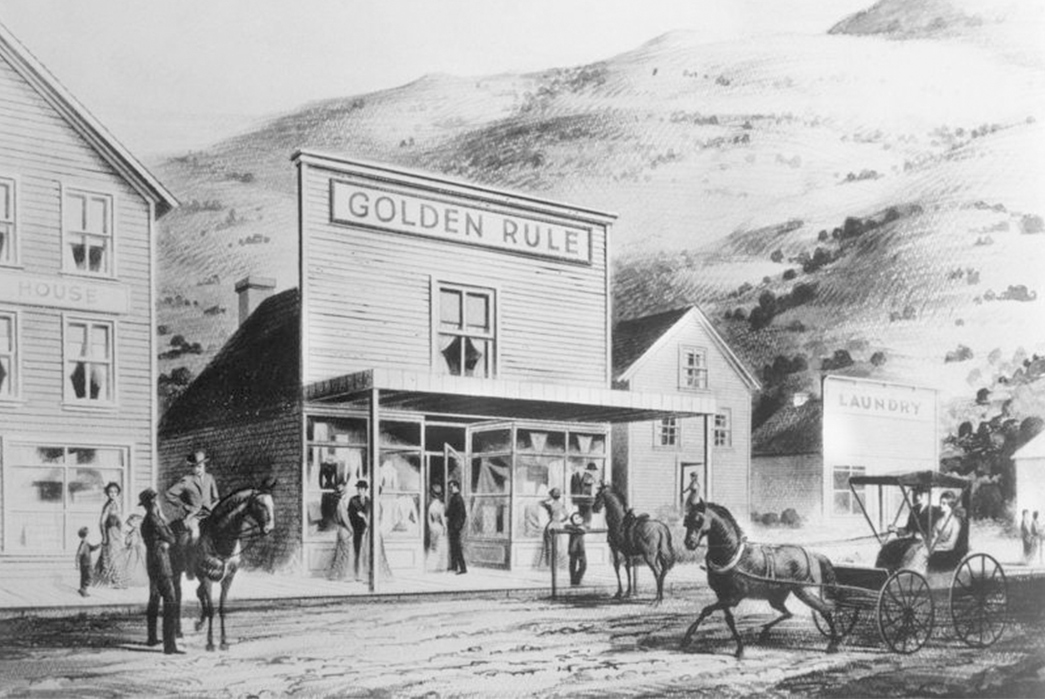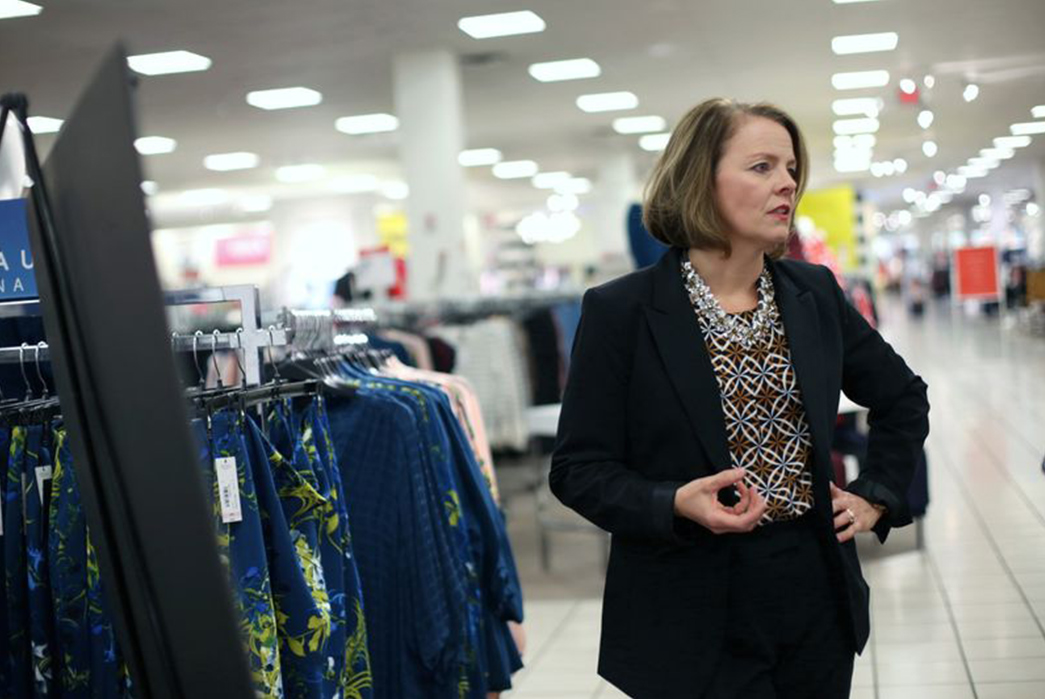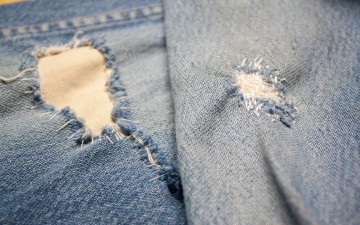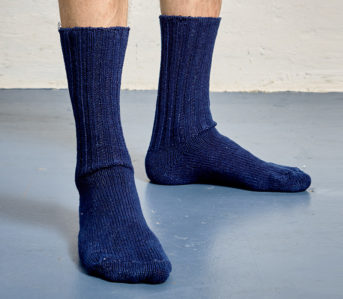It seems that almost every week another mainstay of the American retail landscape declares bankruptcy. This week the unfortunate label is J.C. Penney, a cornerstone in malls across the country.
Though the declaration of Chapter 11 bankruptcy might seem shocking to some, J.C. Penney had been in peril for quite some time. As with our J.Crew article, the pandemic and its fallout were merely the proverbial straw, breaking the camel’s back. Business at the famous department store had long been suffering and it had been the company’s numerous ill-fated responses to changes in retail that doomed them long before the outbreak of covid-19.
J.C. Penney Forgets Its Golden Rule

The store that would grow into J.C. Penney’s. Image via Bloomberg.
In 1902, James Cash Penney opened his first store under the name “Golden Rule.” Though the franchise would eventually take his name, J.C. Penney stores operated under the same golden rule that made his early Wyoming store a success: only take cash. Penney’s stores wouldn’t accept credit for almost fifty years. If the late Mr. Penney knew about the $8 billion debt load that drove his stores into bankruptcy court, no doubt he’d be spinning in his grave.
While many retailers are struggling with their physical locations closed, few have had quite so many setbacks as J.C. Penney. Once tremendously successful, with their famous mail-order catalogues, seemingly every major development in retail since the proliferation of shopping malls in the 1970s, has caused problems for the company. And while the internet rocked the boat for many – if not all, the J.C. Penney franchise took this hit extremely hard, beginning an identity crisis that hobbled the company and saddled it with an unsustainable amount of debt.
2010s Identity Crisis

Jill Soltau. Current J.C. Penney CEO. Image via Bloomberg.
In an interview with Bloomberg in 2019, current CEO Jill Soltau said of the franchise, “It hasn’t been a great shopping experience, I think largely because the company had lost its sight on doing what’s right for the customer.” Despite Soltau’s best efforts, the previous CEOs’ attempts to revive J.C. Penney had only convoluted their own brand and alienated their base.
The first major change came for J.C. Penney in 2011, when the company brought on Ron Johnson, the man who had redesigned the retail experience for Target and Apple to keep those brands’ physical locations relevant, even in the internet age. The result was an unmitigated disaster, with the company losing $4.3 billion in annual sales and within 17 months, Johnson had been ousted.
A change was needed, after all, how could JCP expect to compete with their space-age rivals when they were still using mail-order catalogs? But instead of catering to their current customer base by improving the overall shopping experience, Johnson, high off his meteoric run at Apple, tried to lure in new customers.
He began by changing the store layout, neglecting in-house brands for larger names, and eliminating the markdown/coupon system. This bold gamble was made bolder by the fact he never tested these changes on a small scale, instead rolling them out across all stores. A highly critical opinion piece in The Observer summed up the misguided rebrand.
When Johnson moved to Apple, Steve Jobs was his mentor. Johnson knew the difference between the euphoria created when Apple released a new product and the joy a mom felt saving $5 on a blouse picked from a clearance rack. Fit had nothing to do with Johnson failing at J.C. Penney. He failed because he chose the wrong strategy. Ron Johnson failed because of Ron Johnson.
The urbane Apple consumer would not and could not be lured into the famously affordable catch-all department store. And brand loyalists, who needed the store as a convenient, reasonable place to get their necessities felt cut out.
Mike Ullman, Johnson’s predecessor returned as CEO and was place in the unenviable position of backtracking on all the failed changes. He in turn, was replaced by Marvin Ellison in 2015, a former Home Depot exec. Ellison tried to focus on big-ticket items in the department store, getting J.C. Penny back to selling appliances, something they hadn’t done since the 1980s. He too left and Jill Soltau took over in 2018 and was left in charge of the debt-ridden and mixed-up retailer.
J.C. Penney at Its Best

Ranchcraft Label. Image via Grailed.
One of Ron Johnson’s biggest gambles was sacrificing the stores’ in-house brands in favor of bigger names, which he reasoned might draw in a new kind of customer, previously outside the store’s pull.
Though the store’s personal brands of the 21st century, Arizona Jeans, Liz Claiborne, and St. John’s Bay don’t have much pull in the larger fashion world, they were dependable, well-performing brands. Brands (and this is not a dig) that my grandparents buy, as well as many similar working-class Americans.

Vintage Ranchcraft jacket. Clearly a take on a Wrangler of the same period. Image via Etsy.
J.C. Penney has a rich history of private labels, some of which you’ve undoubtedly seen in vintage stores and some which rival many better-known workwear brands. The company’s first store in Kemmerer, Wyoming carried Levi’s jeans, but as the company expanded and needed to cater to increased demand, they developed their own alternatives.

Heddels Editor David Shuck in a 60s era J.C. Penney Ranchcraft jacket for Hail Mary Magazine.
Big Mac, a famous work-clothes label, is one of J.C. Penney’s oldest, and Ranchcraft, another of theirs, is a well-made, cheaper alternative to vintage Levi’s and Wranglers.
Whether for work or going back to school, Americans have relied on J.C. Penney to clothe themselves and their many hundreds of stores across the country allowed folks without access to “fashion” options a place to dress and express themselves.
Life After Bankruptcy

Image via Wikipedia.
The company filed for Chapter 11 bankruptcy on May 15th in Corpus Christi, Texas. The pre-arranged bankruptcy filing they submitted has the support of some of their creditors, but not all. This means that there will likely be two factions pitted against one another: those who believe the brand has enough solvency to survive the bankruptcy and those who wish to scrap it and sell off its assets.
At last count, the company has 846 stores and a staggering 85,000 employees, the fates of which will hang in the balance, until the company can decide their next move. Though J.C. Penney has until mid July to decide what will become of the brand, some suspect that a significant faction within the company may be leaning towards liquidation, a suspicion which is strengthened by the presence of H/2, a creditor that many believe was instrumental in the liquidation of another bankrupt franchise, Toys R Us. Though a spokesperson for H/2 says that they’re in favor of restructuring, it’s hard to see a future for J.C. Penney, especially after such a rocky few decades.
Regardless, the company obtained $900 million to see it through the next few months and its potential restructuring. J.C. Penney’s fate is uncertain, as are the jobs of its many, many employees. The pandemic shut-down hobbled the ailing giant, one that relies on old-fashioned in-store sales and coupons to keep the lights on. It would be a tremendous loss if J.C. Penney were to be liquidated, but we can only hope that whatever happens next, executives will learn a few lessons.




